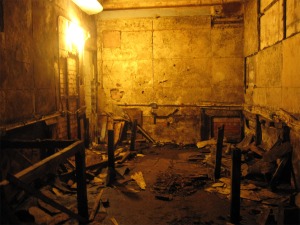Open House London is pretty much my favourite time of year in London. If you’re not familiar with it, check out the premise here.
One of the most exciting buildings to see and explore in 2013 was the incredible World War II Standby Cabinet War Room at Dollis Hill – often called the Neasden Secret Underground Bunker, and nicknamed Paddock. The bunker is open on select occasions, and was only opened to the public for the first time in 2002- at which time it was opened and discovered to be very flooded.
The shelter was planned in the late 1930s as a reserve shelter for government officials, should evacuation of the Central London war rooms occur. It is extremely near to the Post Office Research and Development Station, which was considered a target of the German forces for its technological advances.
Construction began in 1939, and was finished by June 1940. The shelter is a 2 level structure which resides 40 feet below ground. The upper level has a 3 and a half foot thick concrete roof and sides. There is also a 5 foot thick layer of concrete on top of the lower level it to defend against bomb damage. It was designed to withstand a direct hit but, fortunately, this claim was never tested. There are 37 rooms, and you can have a look at the floor plan for these rooms as well as see more information about it at Subterranea Britannica .
The shelter is said to be the place where the last stand for Britain would have taken place, and the location of the bunker does lend to this suggestion. It is located on top of a hill, with what would have been at the time clear views in all directions. There are pill box- type structures with small windows for firing machine guns located on either end to the structure (pictures below) which support this theory.
The building is, and more importantly was, very damp. Even though the facilities were fully decked out to be able to host cabinet meetings (there was a Cabinet room that could fit 30 people, air filtration and air conditioning systems) Churchill spent almost no time in the bunker. He did visit the site on a few occasions- he chaired a meeting of the war cabinet there, and visited it on its completion – but other than that he did not wish, or need, to leave Central London for the relative suburbity of Neasden/Dollis Hill. There was a skeleton staff based at the bunker, but other than that it was not often used during the War as Churchill did not wish to be that far from the centre of London if he could help it.
The Post Office did end up using the bunker, but only in peacetime. Interestingly, it housed their social club around the 1960s- a strange idea as it contains no bathrooms, but the physical drinks bar is still in existence. There was also a recording studio as part of the structure- included so that Churchill could give direct broadcasts from the bunker if needed.
Even though it is now openly referred to as a ‘secret’ underground bunker, during World War II it was so secret that even King George IV was not told of its exact location (BBC.)
One of the best things about the tour we got to take were the excellent staff on hand from Subterranea Britannica. Not only do they know their stuff inside and out, they are genuinely excited about it and more than happy to elaborate on subjects if asked. I was really lucky that the wonderful tour guide we had (Andrew, if I remember correctly), kindly led me around the neighbourhood after the tour to show me some incredible extra bits.
The people at Subterranea Britannica really do go the extra mile for you, and if you’d like to learn more about them or sign up for membership and exclusive underground events, please check out their website here and check them out on twitter @subbrit.
The hallways you see upon entering:
There’s a lot of clambering involved, and hard hats are a must!
A lot of the old machinery is still there – just turned off and left to rust:
There are a lot of remnants of wooden furniture which have been rotted away by the excessive amounts of water in the bunker.
Soundproofing on the walls of meeting rooms and important offices:
The room which served as the recording/broadcast room:
This is not, as I first assumed, the wine rack. It’s the connections for the telephone system.
From the surface: The entry gates to what was the Post Office research Centre.
Machine gun post at the opposite end of the bunker to the Post Office Entrance.
Articles Consulted:














You need to read James Herbert’s Domain!
Nuclear bombs are dropped in London and a man helps someone who is in the government who leads them to the secret bunker that you have spoken about!! I nearly missed a stop on the train because I could have sworn I was down in the tunnels in the thick of the action!